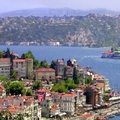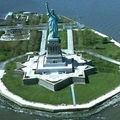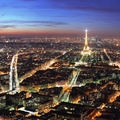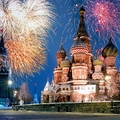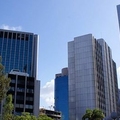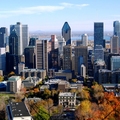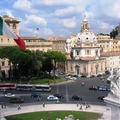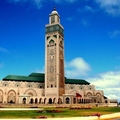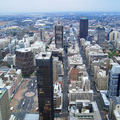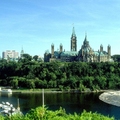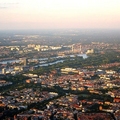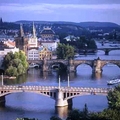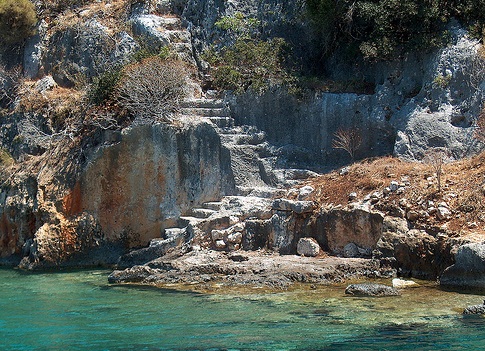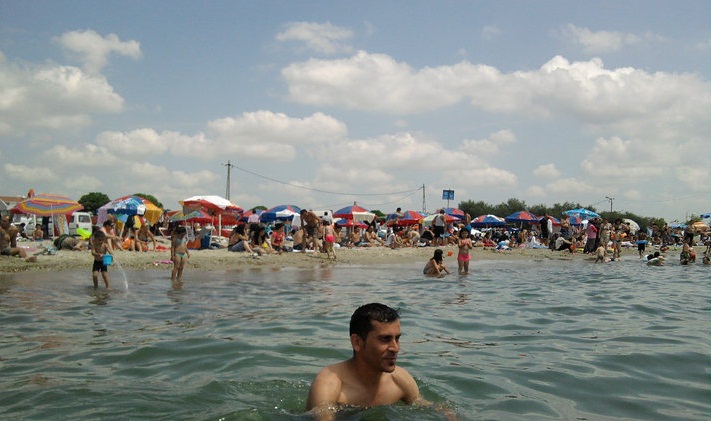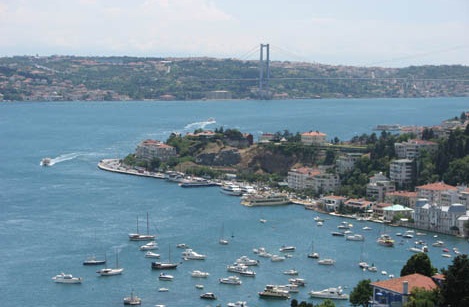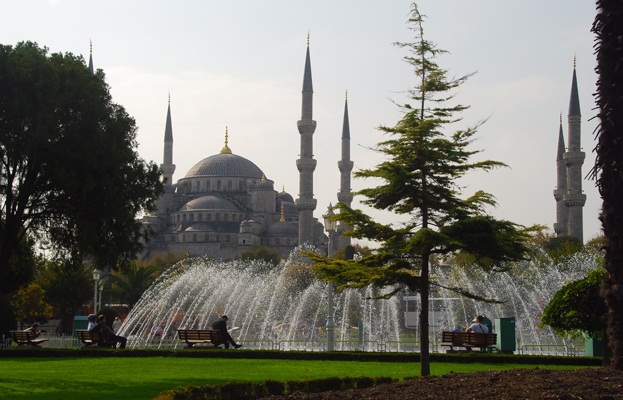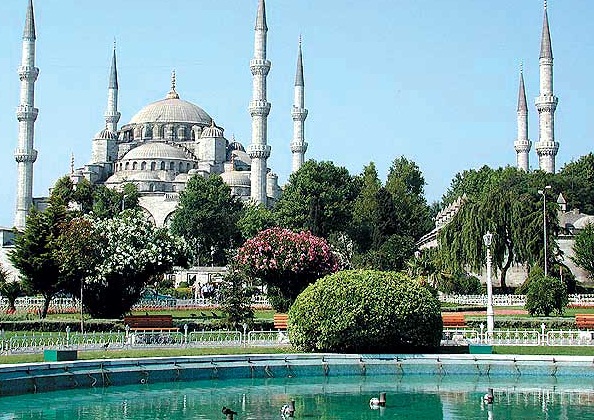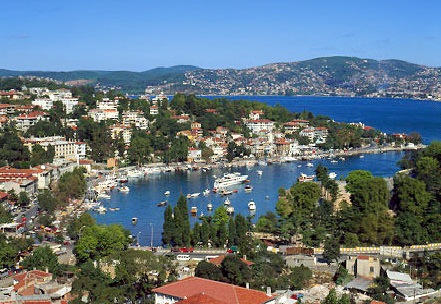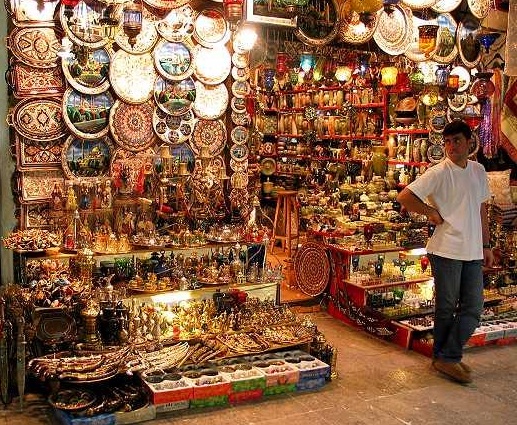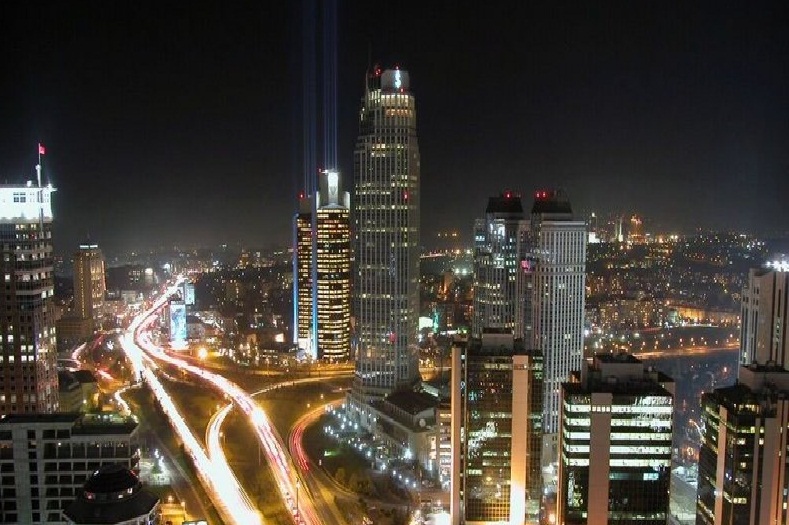Destinations / The best cities to visit in the world / Istanbul-European Capital of Culture
Istanbul-European Capital of Culture
About Istanbul
Probably there is no man in this world, who does not know about the existence of an ancient and magical city on the banks of the famous Bosphorus. This is, Istanbul , of course. The ancient Greek colony of Byzantium, the Imperial Constantinople, the Ottoman capital and the legendary Constantinople of the ancient Russia - all these names represent the city that exists today, keeping old traditions, confident in the future and developing the highest rate. Istanbul is a city which is unique for many reasons. This is truly a city with an unusual geographical location, rich in cultural heritage and, of course, unique nature. Istanbul is one of the few cities in the world, located between two continents - Europe and Asia. It is situated on the majestic hills on both banks of the Bosphorus and to the south it is washed by the Marmara Sea. From an economic standpoint, this location gives the city a huge advantage - the Bosphorus connects the Black Sea with a basin of the Mediterranean, so huge number of ships pass through it. In addition, the European part of Istanbul "cuts up" the most beautiful bay Golden Horn - a symbol of the city. Istanbul covers a very considerable area of 2,106 square kilometers with obscure courtyards, wonderful houses, tangled narrow streets and broad avenues of light, luxurious restaurants and private residences. The population is also big. According to the year 2008 in the large metropolitan Istanbul, there was a population of 16,767 thousand, which is even larger than that of Moscow. In recent years, the number of residents continues to grow rapidly due to the migration from different parts of Turkey and from abroad.
History
The history of the city dates back before Christ, and the foundation date is considered to be 667 BC, when one of the Byzantine towns of Megara marked the beginning of Byzantium, then a Greek colony. However, for nearly one thousand years the city, though having such a good location, has not played a leading role in the life of the ancient world. The situation changed in 324 when it took over a new Roman Emperor Constantine, in which Byzantium turned into a massive construction project, which resulted in 330 when the city already renamed Constantinople became the capital of the Roman Empire. After its collapse in 476 Constantinople remained the capital, but now the Byzantine Empire, which existed for nearly one thousand years until the capture of Constantinople by the Ottoman Turks in 1453. Since then, the city ceased to be a center of Eastern Christianity and became the capital of a Muslim country and of the Ottoman Empire. It is true that in 1923 the city lost its capital status (the main city of Turkey was Ankara), but it didn’t lose its great importance and it continued to grow steadily. Since 1930, the official international name of the city is Istanbul. Naturally, all these troubles could not affect the shape of the modern, multicultural main city of Turkey. Its architecture can be found in the most ancient buildings like the racetrack Roman times, and modern buildings in high-tech style. Istanbul gained world-wide recognition and has unique status as the European Capital of Culture in 2010.
How to get in Istanbul
Since Istanbul is one of the world's major economic and tourist centers, then to go there is not a particular problem. In addition, the city is geographically located not too far from Russia, so there are direct flights from many Russian cities. There are just two international airports in Istanbul - Ataturk Airport and Sabiha Gokcen. The International Ataturk Airport is the largest of the two airports and it is located in the European part of the city, 24 kilometers from the historic center of Istanbul. Direct air service from Ataturk Airport is available in major Russian cities, so that the interface of the flight to Istanbul is not a problem even from the most far-away regions of the country. Direct flights are made in Moscow in Sheremetyevo, Domodedovo and Vnukovo airlines Aeroflot, Turkish Airlines, Atlant-Soyuz, Sky Express, Red Wings and to St. Petersburg there are fly airplanes as "Russia" and Turkish Airlines. Turkish Airlines is the Turkish main carrier and there are direct flights to Yekaterinburg, Rostov-on-Don, Ufa, Kazan and Sochi. Airline Kuban operates flights to Krasnodar. In addition, from Rostov-on-Don and Sochi such planes as fly Donavia of Kazan - Airlines Tatarstan fly and in Yekaterinburg - Ural Airlines.
Climate
The climate in Istanbul is mild and not particularly cranky. Summers are quite hot and winters are cold and snowy or rainy. April-May months in Istanbul are a bit cool (on the Mediterranean standards) , but after these months the air is heated to 30 degrees. From September to December, the thermometer is dropped to 10 degrees, although in September can still be pretty cool to swim. Autumns and winters in Istanbul are often rainy, with snowfall sometimes, the temperature in these months is on average of 9.5 degrees Centigrade.
Sightseeing Places
Istanbul, once called the second Rome is a cluster of historic buildings and to bypass all of them requires more a month. And even if at first sight it may seem modest, with many slums, or just old districts with their intricate houses, this city can really absorb the curious tourists’ eyes. The most important and world-famous historical monuments (some of them can safely be called the eight wonders of the world) are located, as already mentioned, in the central district of Sultan Ahmet, but many remaining places in the city are on Bosphorus area.
Rules for visiting mosques
Believers take off their shoes before entering the mosques. Mind the rules of visiting the mosques. They are usually opened to tourists, but do not go into them during prayers. Daily prayers are done five times a day, in the morning, at noon, in the afternoon, in the evening and at night. The exact time for a prayer is determined by the position of the sun, so that at different times of the year, it is always different. The ideal time to visit a mosque is during the break between prayers. There are also rules related to clothing. Shorts, shirts without sleeves are not acceptable for men. Women should not enter the mosque bare-headed. Before entering the mosque you should take off your shoes. It is best to take a package to put them. You should not behave provocatively in the mosque, laugh loudly, talk, joke or discuss which, in fact can offend the religious feelings of the worshipers, who are almost always in the mosques. Photographing is allowed in the mosques.
The Hagia Sophia
The Hagia Sophia is considered one of the past main churches of Eastern Christianity. After the conquest of Constantinople by the Ottoman Turks in 1453 it was converted into a mosque. According to the legend, the Sultan Mehmed Fatih the Conqueror was so struck by the beauty and grandeur of the church, that decided not to destroy it as many churches of Constantinople were destroyed. In the IV-VI th centuries there was another church with the same name on its place but it was burnt in 532. At the throne was Justinian I the Great, the most famous ruler in the history of the Byzantine Empire. It was under his orders that the construction of a new cathedral began which lasted 5 years up to 537 year. Over the most ambitious construction project of that era presided two prominent architects- Isidore of Miletus and Anfemios of Trallesa. The necessary building materials, columns and stones were brought from various regions of the Byzantine Empire and removed from the other churches of the empire. Ten of thousands ordinary workers and hundreds of artists worked on the construction of the temple that lasted 5 years. St. Sophia was inaugurated on 27 December 537 year. For more than one thousand years, St. Sophia's Cathedral was the largest church of Christendom. In 1204 Constantinople was sacked during the 4 th Crusade, and the Hagia Sophia lost many precious sacred Christian relics, some of which are now kept in the cathedral of San Marco in Venice.
The Blue Mosque
The Sultan Ahmet Mosque is located opposite the Hagia Sophia and the Hippodrome. It is considered the most important mosque of the city. The architect of the mosque was Sedefkar Mehmed Agha. Sultan Ahmet was only 17 when the construction began, and was completed in 1616. The next year Ahmet died of typhoid fever and was buried near the mosque. Above his tomb a mausoleum was built. Along with all mosques of the time, the Blue Mosquee was built as a complex that includes a madrasah – a Muslim educational institution, which serves as a high school and a seminary, a hospital, a bathhouse, an elementary school, an imaret, a market Arasta and many others. The mosque has a courtyard, which has three gates. In the middle of the courtyard is a fountain for ablutions. Of particular interest is that this is the only mosque in Istanbul, once with 6 minarets. Three balconies are available in four of them and these minarets are located in the corners of the mosque. Two other minarets with two sherefe are located in the corners of the courtyard. Facilities inside the mosque are huge and completely filled with wonderful light which penetrates into the mosque through 260 windows in a special arrangement. At the entrance to the mosque, it becomes clear why it is called "Blue" - the entire interior is predominantly filled with those colors. The blue tiles on the walls are especially dazzling. Nevertheless, the floor is carpeted with cherry red hues. The dome of the cathedral, no doubt, was built in the imitation of St. Sophia’ dome. Its diameter is of 33.6 meters and its height is of 43 meters.
The architectural complex of the Süleymaniye
The architectural complex of the Süleymaniye is one of the biggest around Istanbul and the main mosque and the largest in the city. It was projected by the famous architect Mimar Sinan and the customer was the Sultan Suleiman I legislator. The construction began on June 13, 1550 and it ended in 7 years - in October 1557. There were three participants and a half thousand people, among whom 1,700 professed Islam. Stones, columns and other building materials were imported from various regions of the empire. The total ensemble includes 15 objects at once: the mosque, 6 madrassas (Daryulhadis, Ruby, Salis, Evvel, Sani and Typ), a medical school, the tomb of Suleiman I, the tomb of his wife Khurram Sultan, room Tyurbedar (tombs of the superintendent), a hospital, a dining room, a hotel, a sauna and the tomb of the greatest Ottoman architect Mimar Sinan. One of the main features of all that Mimar Sinan created is its surprising simplicity, but in the same time its sophistication and grandeur. The interior of the mosque rather modest in comparison with the Blue Mosque creates a kind of special atmosphere. There are very original stained glass windows near the mirhabom and the columns of the XVI century wizard Ibrahim.
The Topkapi Palace
The famous Topkapi Palace was the residence of the sultans and the administrative center of the Ottoman Empire from 1465 to 1853 years. Formally, the building was completed in 1479, but later the territory and the number of extensions of the palace which is also known as Sarah and Jadid-Amir, expanded. The total area of the palace is of 700 000 sq. km. It is one of the seven hills of the city and is surrounded by broad and fairly high walls with 28 towers. In 1888, the railway construction of the walls had been demolished, but, nevertheless, most of the walls still survive. The palace consists of several buildings with four courtyards, connected by gates. Thus, remembering the building of the palace complex which was located in the first courtyard of the Topkapi Palace, Church of St. Irene. This is, in fact, the only Byzantine church in the city, from ancient times.
The Hippodrome
The entertainment center of the ancient Constantinople, also known as the Byzantine Hippodrome is called the Sultanahmet Square. The entrance to the racecourse is free and it is easy to look at the ancient monuments of Istanbul, located here.
The Dolmabahce Palace
This is the last palace of the Turkish sultans. It is located in Besiktas region. The Dolmabahce Palace was built in 1842 by the architect Karabetom Balyanom for Sultan Abdulmajid I, intending to transfer residency here from the Topkapı Palace, fact which happened in 1853.After the establishment of the Republic of the Dolmabahce the Palace became the official residence of Mustafa Kemal Ataturk, where he died on November, 10,1938. It happened at 9:05, and since then all hours of the palace only show this time. The palace complex includes a variety of buildings: the Harem, the Clock Tower, the Dolmabahçe Mosque, a library, and many others.
The Architectural Ensemble Sultan Mihrimah
This is one of the two architectural complexes of Istanbul, built in the honor of the daughter of Suleyman the Magnificent, Sultan Mihrimah. One of them is in the area of Edirnekapı, and this ensemble is located opposite the ferry terminal Uskyudar. The architect himself was Mimar Sinan. Besides the mosque there is a madrasa, a school, as well as the tomb of Sinaneddina Yusuf and Grand Vizier Ibrahim Ethem Pasha concentrated here.
The Galata Tower
Another symbol of the city is situated in the north of the Golden Horn. The Galata Tower is one of the tallest towers of old Istanbul. Its height is of 63 meters and its diameter is of 9 meters. It offers stunning panoramic views of the city, on Bosphorus and on the Golden Horn. The tower was built by the Genoese in the years 1348-1349 as part of a protective wall around the quarter of Galata, located opposite the historic part of Istanbul. Not far from the tower is the Tyunel square with the funicular station and a retro-tram, from which will need to go down a couple of quarters.
The Rustem Pasha Mosque
The Rustem Pasha Mosque is located in the busy commercial district of Eminonu, near the Golden Horn. Its construction lasted from 1550 to 1561 years under the leadership of Mimar Sinan for Rustem Pasha, the stepson of Sultan Suleyman the Magnificent. Twice in its history, the mosque suffered considerable damage,a fire in 1666 and an earthquake in 1776, but each time it was restored.
The Fatih architectural ensemble
In fact, this is the first architectural complex, built in the city after the Turkish invasion. Located on Prospect Fevzi Pasha in the Orthodox area of the Fatih complex consists of mosques, madrasas, hospitals, baths, libraries, markets and tombs. The construction continued 7 years and it was completed in 1470. Earlier this place was a Byzantine church Havarium, but Fatih complex was completed already in a purely Turkish style, with no apparent borrowings from the Byzantine architecture. Its architect was Atik Sinan.
The Basilica Cistern
In antiquity many underground reservoirs were established in Constantinople to supply the city with drinking water in adverse times (during the siege, for example). The largest of all extant to this day (they are about 40) is the Basilica Cistern, located in the historical heart of Istanbul, close to the St. Sophia Cathedral. The Bayyazit architectural complex Built in 1505 by order of Sultan Bayyazita, the architectural complex in the same area, as well as many others like it, includes several buildings. Unfortunately, we do not know who is the architect of this complex. The complex consists of a an inn, a mosque, baths, madrasas, a hotel and a primary school. Most of the buildings have found a second life today . The Museum of madrassas is used in calligraphy.
The Tekfur Palace
Tekfur Palace is not far from the ancient walls between Edirnekapı and Egrikapy. How old it is, though, just no one can say. According to some dates, it was built under the Emperor Constantine Porfirogene as an extension to the palace that stood previously there. Other sources report that it was built by Tekfur Blakhernay in the XIII-XIV centuries.
The Maiden Tower
The second famous tower in Istanbul is called the Maiden Tower. It is located 200 meters from the shore quarter Saladzhak and the Asian region Uskyudar. The exact date of the construction of the tower is not known by anybody, but due to some accounts its history goes back to the IV century BC. There are many legends about the tower. Throughout its history the tower had the role of a watchdog, a place to collect taxes from passing ships through the Bosphorus. It was also used as a radio station, a lighthouse and even a quarantine insulator during the cholera epidemic in 1830.You can see how different boats from the area Kabatas are leaving on the European shore of the Bosporus and the quarter Saladzhak in Asia.
The Armenian Church
The oldest Armenian church of the city is the church of St. George the Illuminator. It was built in 1431 on the site of another church - St. Sarkis. The church was destroyed many times. The last time it happened in 1958 during the construction of the road between the districts of Karki and Tophane. In the first half of the 60-ies of the XX century the church recovered from the remaining stones. The official opening took place on May 15, 1966 with the participation of Patriarch Galustyan.
The Aqueduct of Valens
The most famous aqueduct in Istanbul - Valens, is the main aqueduct in the water supply system of Constantinople. Today it is located in the central part of the boulevard of Ataturk and is considered one of the main symbols of Istanbul. The aqueduct was built in the late Roman period of Emperor Valens, about 368-375 years. It became an important part in the water supply of the capital of the Eastern Roman Empire.
The City Walls
One of the main attractions in Istanbul are the City Walls, a 22 km stretch in a few areas. The marble walls are along the shores of the Marmara Sea coast. The Gulick and the Galicheskie wall, and the district Zeytinburnu are earthen walls of 5420 meters in length, which have 123 towers. The first of these walls was the Murmur Tower on the beach, and they finished in Edirnekapı. Two series of walls, an inner and an outer one are separated by a moat. The walls have 36 large and small gates, the main 6 of them are located in Zeytinburnu district. These are the Altin Kapi (or Yaldyzly Capa), Belgrade, Capa, Capa Silivri, Yedikule Capa, Capa Mevlana and Topkapi gateways.
The Golden Gate Altin Kapi
Located a kilometer away from the tower of Murmur, the Gates Altin Kapi, or the Golden Gate is considered the most important of all in the fortress. It is this gate that lead to Rome in the past. Emperor Theodosius I established a winning arch here, after which the gates were the main throughout the city. They drove the emperors and the army returned after military victories. Two towers were built by the Emperor Theodosius II, on both sides of the arches .Later they were joined by walls, which resulted in the new gates, called "gold" gates due to the fact that the facade of the arch was decorated with gilt decoration.
The Fountains of Istanbul
Besides mosques in Istanbul you can look at the traditional attributes of the large cities-the fountains. It's worth to describe the most notable fountains because their structures differ from the fountains in the traditional style , but there are classic fountains in Istanbul too with taps for drinking water. Some fountains in Istanbul are: the German Fountain, the Fountain of Sultan Ahmed III, the Esma Sultan Fountain, the Tophane Fountain and the Aisha Sultan Fountain. Being in such a wonderful and contrasting city like Istanbul, you will never get bored. . This city with its diverse traditions can give everyone a sense of celebration and, on the other hand, a sense of spiritual enrichment. In Istanbul you can find entertainment to suit every taste - from family vacations in city parks, to hyperactive nightlife, which has already become famous in Istanbul. Istanbul has everything - wonderful parks and museums, countless bars and clubs, cultural centers, cinemas and a wide variety of festivals! These places and just others confirm the thesis that Istanbul can tighten the long haul. And this is without doubt, there will be nothing wrong to say this because such cities need special attention and attitude.
The Princes' Islands
An excursion to the Princes' Islands must always be a must-see destination while visiting Istanbul. The Princes' Islands is a small archipelago of nine islands in the Marmara Sea near the Asian coast of Istanbul, about 20 kilometers southeast of downtown. The place is called so because of the same tradition of the Byzantine emperors, the link to their closed relatives. Princesses were often blinded or simply executed or kept in the dungeons here. Locals often refer to these islands just as Adalar island. This is the place where regular ferries from Istanbul, with quarters Bostanci, Kadıköy and Kartal on the Asian side quarters and from Kabatas and Sirkeci for Europe take place. Summer ferries are often filled to overflowing, and carry up to 1500 passengers per flight. At this time, it is always worth taking a ferry ticket early and be on the docks, maximum 15 minutes before the departure. The ferry makes a stop at the fourth pier of the islands. The Princes' Islands is a popular holiday destination in itself, where many houses and cottages are often rented here for the summer, or simply spend their weekends here. The four main islands with ferry docks are Byuyyukada, Heybeliada, Burgazada and Kynalyada. The Sedefadasy Island is also populated, but not so much, and therefore less popular. The Tavsanadasy, Sivriada and Yassiada Islands are not inhabited and the Kashikadasy Island is a private property. You can rent a cart with the driver and drive around the island on the Proydya perimeter.
In addition to Turkish coffee, there is another cliche, without which Turkey is difficult to imagine - it is, of course, about the Turkish baths (hammam). It's like to join something sacred, a true ritual that must not doubt the guest of Istanbul. Turchish baths are many, but some of them are themselves monuments of history and art. Some of the most famous are the Dzhagaloglu, the Galatasaray, the Chemberlitash, the Old Bath Uskyudar and others.
Visit museums
With such a rich history, Istanbul simply cannot be a city of museums, its countless artifacts "telling" visitors about how it lived and how it had survived, what is this city now and how it was two and a half thousand years ago. Many museums are located directly in the historic center, so that there is no problem to reach to them.
The Archaeological Museum
The Archaeological Museum of Istanbul is one of the most important museums of the city, which is located in the center, near the park Gulhane and Topkapi Palace. The Entire museum complex occupies three buildings, including the building of a museum of the Ancient East and a tiled pavilion. The museum holds more than one million objects belonging to different eras and cultures.
The Museum of Turkish and Islamic Art
The Museum of Turkish and Islamic Art was opened on Bosphorus on the 22 May, 1983 in the palace of Ibrahim Pasha at Sultanahmet Square. This palace was built in 1524 and is a unique monument of architecture in itself. The Museum stores more than 40 000 different treasures of antiquity inside, which have long been gathered from archaeological sites, mosques, etc. Here you can see the unique manuscript books and manuscripts VIII-XIX centuries (they are in the museum about 15 000), articles from ceramics, the richest collection of carpets, jewelry, clothing and much more. The things associated with the personal life of Ottoman sultans are of particular interest.
The Museum of Turkish calligraphy
It is a unique museum. It is the only museum of calligraphy in Turkey. It houses a former mosque, Beyyazid madrasa, where the municipal library was located before. By the way, the Sultan Bayyazit II was himself a passionate lover of calligraphy.
The City Museum
Another interesting museum in Istanbul is the Museum of the City, where a permanent exhibition gathers many items connected with the life of Istanbul in the Ottoman era. Originally founded in 1939, the museum is housed in the Municipal Library Beyyazit, but in 1988 opened its doors to visitors in the Hall of Fine Arts, in the Yildiz Palace , Besiktas district. Here you can see many exhibits of calligraphy, textiles, glassware, ceramics, tableware, fine art and others.
The "Miniatyurk"Park
With a view on the Golden Horn on the observation platform at the cafe Pierre Loti, the Istanbul "Miniatyurk" park has an area of 100,000 square meters. The park was opened not so long ago, in 2003, and it has already become one of the city's attractions. The park presents 105 works - miniature copies of Turkish monuments in 1:25 scale, made by masters from both Turkey and from abroad. Located in the Bay area the "Miniatyurk” park is the largest park of its kind in the world. In the future, the number of thumbnails will likely increase to 400.
The Gulhane Park
Surrounding Topkapi Palace , the Gulhane park is one of the favorite places for recreational activities in Istanbul that visitors like. The convenient location in the heart of the city and the fact that the place is situated where the Golden Horn merges with the Bosphorus and Marmara Sea, as well as fine furnishings make the park more attractive for leisure.
The Emirgan Park
One of the most beautiful parks in the city is the Emirgan Park on the European shore of the Bosphorus, located in the same area in the northern part of the city. Although distant from the center the park, however, deserves special attention. Occupying an area of 300,000 square meters in the coastal hills, it got its name in the honor of the Persian princess Emirhana where the Ottoman sultan was given a palace.
Nightlife in Istanbul
Istanbul never sleeps. This city is active 24 hours a day, and we can say that for many people, the fun begins at night. The choice of nightlife in Istanbul is really great, and it is only necessary to find a suitable option among many possible. In the famous world of Istanbul bars and nightclubs one can enjoy a wonderful night fireworks show, or simply dance at night with a romantic view on the Bosphorus. Another option will bring you to the traditional Turkish culture, listen to Turkish folk music, enjoy the belly dancing or folk concepts can be seen in any of the numerous Turkish bars and cafes. If a visitor of the city prefers other music, such as rock, punk rock, techno, rave, jazz or alternative, then it's not a problem. You may find these in the bars and clubs on the boulevard Istiklal and its side streets, street Kadife in Kadıköy and shore of the Bosphorus in Ortakoy with it all right. For those more interested in romance than loud music, and who wants to spend an unforgettable evening while enjoying views on the Bosphorus, there are many excellent places on the coast districts Kurucheshme and Bebek. And in the Etiler quarter you can have a great time, singing Turkish songs and dancing to live music. Istanbul is one of the largest cities not only in Europe but in the world which population increases every day.
Soon, Istanbul, will be the most populated city in Europe. However, the most paradoxical in this case is that the crime rate in Istanbul is one of the lowest, if we consider the world's megacities. According to the Consortium of EU Crime and Security in Istanbul, a victim of crime is 18 people out of 100, while, for example, in London - 32 and in New York - 23. According to the results for the year 2005 in Istanbul, there were 148,165 crimes. To a great extent this situation is due to the project «MOBESE» (Draft Integration of mobile electronic systems) and effective law enforcement structures. The total amount of crime over the last couple of years has fallen by more than 20%, and minor crimes such as pickpocketing lowered with 59%. Within the above-mentioned project many streets and squares of Istanbul were equipped with surveillance cameras, especially in the busiest places. The police in Istanbul, is technically well-equipped.But be that as it may, the big city is a big city, and basic safety rules are still needed to comply. In particular this applies to places of mass gatherings such as Istanbul's bazaars.
Maps of Istanbul-European Capital of Culture
map Turkey -> Maps Istanbul -> map Istanbul Images of IstanbulOthers from The best cities to visit in the world
If you plan to go somewhere this summer you're welcome to discover new things about some of the best cities in the world which attract thousands of visitors each year.

